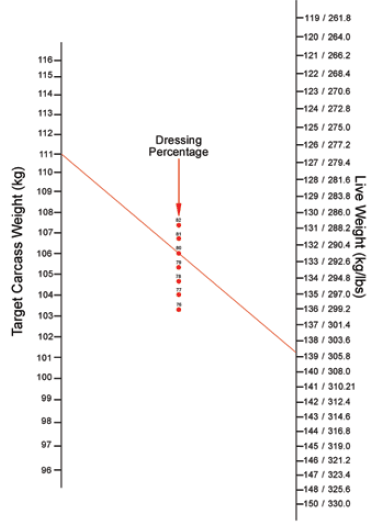



Hog Target Weight Calculator for Heavy Hogs
Improving market weight accuracy can greatly improve revenue, according to Jaydee Smith, Swine Production Systems Program Lead with Ontario Ministry of Agriculture, Food and Rural Affairs, in the latest 'Pork News & Views' newsletter.The carcass weight targeted by a hog grading grid primarily determines when hogs are marketed. A variety of factors, from pig variation to space requirements to holidays, influence shipping practices that result in a lessthan- perfect fit with the grading grid's target range. Some of these factors can be controlled or managed in order to maximise financial returns.
Sort Loss
Revenue is lost when carcasses miss the grading grid's targets
for lean yield or weight. While the value of this loss is not itemised on the
settlement statement, it can be estimated by tallying the numbers of
carcasses on the statement that did not fit into the target and calculating the
resulting revenue missed. Even if the average weight and average lean yield
of a group appear to hit the target, many carcasses may, in fact, lie outside
it. While an average weight for a pen may seem adequate for shipping, it is
important to remember that carcasses are graded and priced individually.
In herds where weights are closely monitored and hogs are shipped
weekly, 66 per cent of carcass weights fall within plus or minus 4kg of the
average weight. Some grids will accommodate biweekly shipping without
penalty as long as weight is accurately monitored. With a narrow
grid, accurate weekly shipping can be very important.
To minimise this source of lost revenue, pay careful attention to the grading
grid being targeted and know the shipping weight necessary to achieve
the best possible fit with the targeted carcass weight and lean yield. Understand
the growth characteristics of the pigs and the dressing percentage
(DP) at the packing plant by routinely reviewing shipping weights and
the resulting settlement statement. Knowing how shipping weight affects
carcass weight and lean yield will help pork producers effectively adjust
their shipping strategy. Getting the shipping weight right is a fundamental
starting point. There is always variation in a herd but here is where it can
be managed, at least to some extent. Grading grids use a sharp cut-off, not
a gradual one, and hitting the next higher weight class could mean a loss of
significant index points, resulting in lost revenue.
To determine the required shipping weight depending on
the target carcass weight and DP quickly, use the Hog Target Weight Calculator
(Figure 1). The target weight calculator can be used to see what carcass
weight is likely to result from shipping hogs at a given live weight,
or to see what effect a change in DP (which may result from extended
transport times) might have on carcass weight.

(shipping weight in kg and lb)
Carcass quality can also be affected by handling decisions; shipping time is not the time to take chances with the investment already made in a finished animal. See the publications Should this pig be transported and Caring for Compromised Pigs, available from the Ontario Farm Animal Council (www.ofac.org).
The Target Weight Calculator
The target weight calculator diagrammatically
relates carcass weight, carcass DP and live weight. The calculator
can determine a shipping weight given a target carcass weight and
an estimate of DP (or vice versa). Figure 1 shows the Hog Target Weight
Calculator with shipping weight provided in kilograms and pounds.
Using the calculator, producers can determine the target shipping
weights for their hogs, based on the current grid, or the potential
shipping weight, based on the target weight range of a new grid. They
can also estimate the carcass weight resulting from shipping hogs at a
given live weight, or determine what effect a change in DP might have
on carcass weight.
Using the Calculator
- Find the target carcass weight (from your grid) on the left axis.
- Estimate your DP (from records, or use 80 per cent).
- Use a straight edge to read across from the target carcass weight through the DP to find the target live weight.
- Reverse the procedure to determine carcass weight based on a given live weight.
Your information
Lower target carcass weight ________ kg
Upper target carcass weight ________ kg
Dressing percentage ________ %
Lower target shipping weight ________ kg or ________ lb
Upper target shipping weight ________ kg or ________ lb
January 2013








